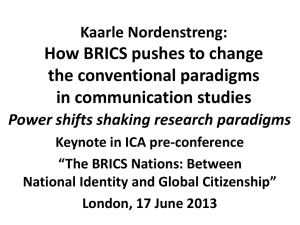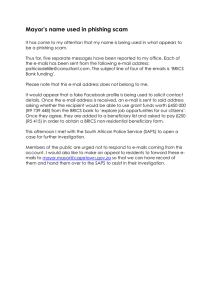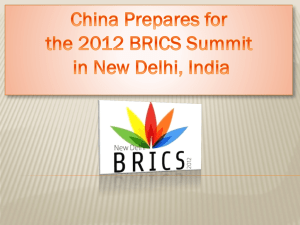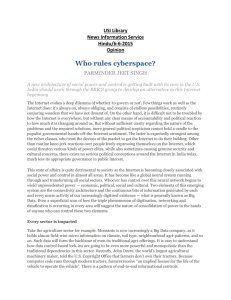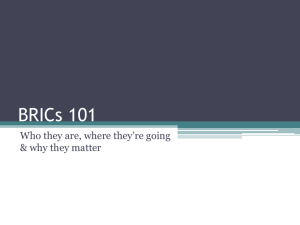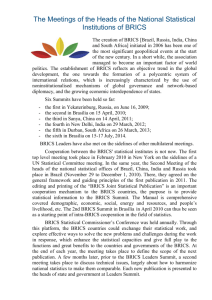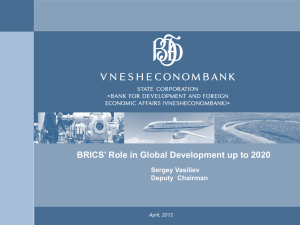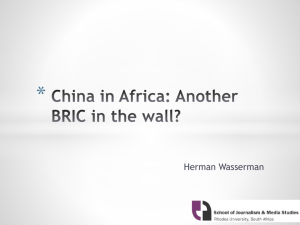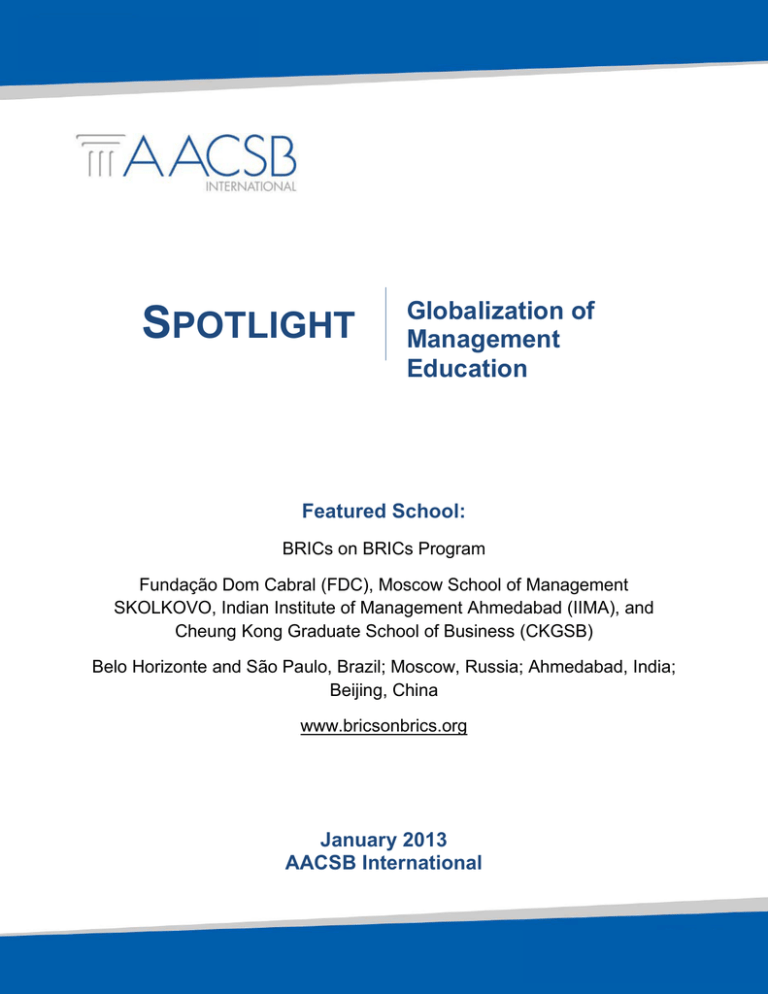
SPOTLIGHT
Globalization of
Management
Education
Featured School:
BRICs on BRICs Program
Fundação Dom Cabral (FDC), Moscow School of Management
SKOLKOVO, Indian Institute of Management Ahmedabad (IIMA), and
Cheung Kong Graduate School of Business (CKGSB)
Belo Horizonte and São Paulo, Brazil; Moscow, Russia; Ahmedabad, India;
Beijing, China
www.bricsonbrics.org
January 2013
AACSB International
SPOTLIGHT | Globalization of Management Education
BRICs on
The BRICs on BRICs Program
Business and economic activity in the BRIC countries and in emerging markets has been an important
area for research and discussion among the business community, governmental organizations, and
academics. Since being launched in 2010, the BRICs on BRICs Program has been offering working
professionals the opportunity to interact with professors, industry leaders, and community members in
BRIC countries, and gain a real-world perspective on leading business in these countries.
An initial “draft” for the BRICs on BRICs Program was presented in December 2006 at the request of
Dean Emerson de Almeida and Professor Aldemir Drummond of Fundação Dom Cabral (FDC) in Brazil
for creation of such an initiative. In 2007, together with a colleague from Hautes Études Commerciales de
Paris (HEC Paris), Aldemir worked on the development of the profile of participants, methodologies, and
content for the future program. In 2008, Carlos Arruda, Associate Dean International Affairs at FDC and
Director of the FDC Innovation Center, became involved in a global study on several companies in the
BRIC countries and the public policies that support them. The project, which was directed by the Vale
Columbia Center on Sustainable International Investment, helped initiate the collaboration between the
Institute and the four BRIC business schools: FDC, Fudan University, Indian School of Business (ISB),
and Moscow School of Management SKOLKOVO. Together, the five institutions, referred to collectively
as the “Five Diamonds”, would offer a series of meetings and conferences on business in the BRIC
countries. The initial meeting, which was held in New York City, led the business schools to realize that a
significant gap of knowledge existed among countries and multinational corporations on the business
situation in emerging countries. This “presented a clear opportunity to do something in this space,” says
Arruda, and prompted the business schools to discuss ways to address the gap.
In 2009, the group had its second round of the Five Diamonds conference series in Brazil at which the
deans of the four business schools concluded that an executive education program could complement the
research and the discussions at the conferences and focus on global integration as opposed to lateral
investments among these countries.
Program Structure
The BRICs on BRICs Program provides participants and global companies with the “knowledge, skills,
1
and insights to successfully invest and operate in the BRIC countries.” The Program’s creators realized
that although there is widespread belief on the immense potential within the BRIC countries, knowing how
to operate and conduct business in these countries is less known. To address these challenges,
participants address both the macro perspectives of each of the BRIC economies that they visit, as well
as micro-level details of operational excellence in those countries.
© AACSB International. All Rights Reserved.
2
SPOTLIGHT | Globalization of Management Education
BRICs on
The Program is designed to offer a series of modules delivered at each of the four participating business
schools (Fundação Dom Cabral (FDC), Moscow School of Management SKOLKOVO, Indian Institute of
1
Management Ahmedabad (IIMA), and Cheung Kong Graduate School of Business (CKGSB) ) over a
period of nine months. Each module analyzes one of the BRIC countries (Brazil, Russia, India, and
China) from three perspectives:
1. Markets (Business-to-Business and Business-to-Consumer)
2. Sources of efficiencies across value chains
3. Management practices that are effective in those countries
3
In addition to these perspectives, each module also highlights macroeconomic aspects of the country and
its culture, including the impact of the national culture on leadership and differentiating factors that make
the country attractive for investors.
Arruda explains that the four business schools represent the “core of the BRICs on BRICs Program,”
delivering the same basic curriculum (although with a different focus country) to enable the participants to
compare and synthesize their experiences. Classes are taught in English by local faculty with deep
knowledge of the local environment. Participants spend one week in each of the four countries. They
typically arrive on a Sunday and classes always finish on Friday morning, in order for the participants to
have time to return to their home countries during the weekend.
The first module, offered in Brazil, begins by offering broad perspectives on emerging economies and the
BRIC countries. The final module is delivered in China and concludes by asking the participants to
compare and contrast what they have acquired in each of the BRIC countries visited. The program
pedagogy consists of live cases, company and household visits, and interactions with top level speakers
from industry and government. The experiential aspect of the modules is an important part of the
Program. As an example, Arruda shares that within the Brazil module, participants are exposed to “the
huge issue with social inclusion. More than 50 million Brazilians are at the poverty level to middle class. It
is important for participants to go to the houses and meet the wives, husbands, and children to
understand this phenomenon.” Each module is different. In Russia participants mainly visit shops to see
the differences among “blue collar” shops, middle class shops, and high-end stores. Arruda also adds
that they decided to deliver the Russia module in December so that students “can truly experience the
winter in the country” and see its effects on the country’s culture and way of living.
1
Fudan University and Indian School of Business delivered modules only in the first year of the BRICs on BRICs
Program, and were replaced by Cheung Kong Graduate School of Business (CKGSB) and Indian Institute of
Management Ahmedabad (IIMA).
© AACSB International. All Rights Reserved.
SPOTLIGHT | Globalization of Management Education
Initially, the Program consisted of six modules. The first module was delivered in the United States with
the remaining three modules held in Brazil, China, and concluding in France. The goal of the first
module (in the US) was not only to look at the BRICs from the North American perspective, but also to
establish the conceptual framework of the program. Within the last module, in Paris, participants were
given the opportunity to compare and contrast the Program in a different environment after spending
time in and being exposed to the four BRIC countries.
Arruda explains that after the first year, the Program reduced the number of modules from six to four, in
response to participants’ feedback. Further, considering that the majority of participants were senior
executives already with strong conceptual backgrounds, a module specific to the conceptual framework
of the Program was not necessary. Arruda adds, “We came to the conclusion that the focus of the
Program’s participants was mainly on the BRIC countries. We agreed that there was not much value in
the New York and Paris modules; participants wanted to learn more about the BRIC countries and the
experiences there.” Going forward, the four modules were made a requirement (versus being optional)
with the goal of having the entire cohort participate in country visits and to enhance the classroom
learning experience within each of the modules.
Program Participants
The BRICs on BRICs Program is an open enrollment, non-degree executive education program.
Students are not evaluated through a final exam or final project, but do receive a certificate of
completion signed by the four business schools. The Program targets:
•
CEOs and heads of business units of companies with business interests in BRIC countries
•
Executives from multinational companies in charge of global strategy and business development
•
Executives from BRIC countries who are keen to evaluate new markets and build networks and
partnerships
•
Investment professionals interested in BRIC countries
•
Executives who plan to work in or with BRIC countries
•
Government officials interested in understanding the BRIC economies and business
environments
4
Several industry sectors are represented, including automobiles, steel, mining, logistics, and insurance.
The first cohort included participants who were executives from the four countries plus representatives
from European- and U.S.-based multinational companies. In the second cohort an individual from Korea
and an individual from the U.S. also participated. Arruda explains that it has been challenging attracting
© AACSB International. All Rights Reserved.
BRICs on
SPOTLIGHT | Globalization of Management Education
BRICs on
participants from outside the BRICs, but it is something that the Program hopes to improve on as it gains
more global exposure.
The BRICs on BRICs Program helps participants position their companies for profitable growth, and
promotes the following learning objectives:
•
Make more informed decisions to take advantage of the market and value chain opportunities in
each of the BRIC countries
•
Leverage opportunities presented by the rise of BRIC countries for developing their company's
global strategy
•
Understand how to adapt global business models to compete successfully in BRIC countries
•
Analyze and take advantage of the differences in management
•
Build networks with key influencers in the government and the private sector within each of the
four countries, as well as with their peers in the program
•
Contrast and combine investment opportunities across the four BRIC countries
5
Equal Partners
To participate in the BRICs on BRICs Program, each school agrees to provide the faculty and content for
its own hosted module, as well as a minimum of seven participants. If a school fails to recruit enough
participants then it is responsible for the unrealized revenue. The group of faculty that delivers the
program typically remains the same from year to year.
Participants pay an application fee of 25,000 USD for the program; however, since each school is better
aware about its own market, they may charge different program fees or provide additional discounts.
Partnerships between a school from a developed region and a school from an emerging region are
common these days, while the concept of schools solely within emerging countries coming together to
teach and learn is new, explains Arruda. Schools from emerging markets have a lot to teach, but
communicating this effectively can be a challenge. Further, finding alignment between four schools in four
different regions of the world can be an arduous endeavor when delivering such an ambitious executive
program. Arruda jokingly compares the partnerships to a “wedding with four people. With two, it’s hard
enough!”
© AACSB International. All Rights Reserved.
SPOTLIGHT | Globalization of Management Education
Future Opportunities
The BRICs on BRICs Program is not a low hanging fruit for any of the schools involved, and represents a
considerable undertaking on behalf of all the schools. However, the “perception of opportunity” as well as
the support and open communication between the schools’ deans and program directors have greatly
impacted the Program’s success thus far.
Feedback from participants and companies who have completed the Program show that much value can
be gained from the Program. For example, one of the participating companies decided to invest in Russia
stating that the Program helped them move ahead with the decision. Another company in Brazil, on the
other hand, decided not to invest in one of the regions, after the program helped them realize it would not
be the best business decision for the company.
Opinions differ on whether the BRICs on BRICS Program should be expanded to other degree levels,
e.g., to MA/MBA students. Arruda feels that participants gain more from the Program when they are in an
executive position within a company and have significant experience in their industry and working with
other international organizations. Others, like Antonio Batista, Academic Director of the Program, see
more of an opportunity for tweaking the program to be delivered through a type of globalized MBA format.
However, Arruda mentions that “proposing the question creates an opportunity for discussion” and
whether the Program would be suitable to MA/MBA students will surely be assessed as the program
progresses.
Acknowledgements: AACSB International is grateful for the assistance of Carlos Arruda, Associate Dean
International Affairs at Fundação Dom Cabral (FDC) in Brazil and Director of the FDC-Bradesco
Innovation Center.
© AACSB International. All Rights Reserved.
BRICs on
SPOTLIGHT | Globalization of Management Education
End Notes
1
BRICs on BRICs Program (2012). The BRICs on BRICs Program at a glance webpage,
http://www.bricsonbrics.org/index.html, accessed on December 4, 2012.
2
BRICs on BRICs Program (2012). The BRICs on BRICs Program at a glance webpage,
http://www.bricsonbrics.org/index.html, accessed on December 4, 2012.
3
BRICs on BRICs Program (2012). Program Design webpage, http://www.bricsonbrics.org/program-design.html
accessed on December 1, 2012.
4
BRICs on BRICs Program (2012). Program Design webpage, http://www.bricsonbrics.org/program-design.html
accessed on December 1, 2012.
5
BRICs on BRICs Program (2012). Key Takeaways webpage, http://www.bricsonbrics.org/key-takeways.html
accessed on December 1, 2012.
© AACSB International. All Rights Reserved.
BRICs on

